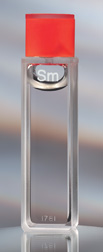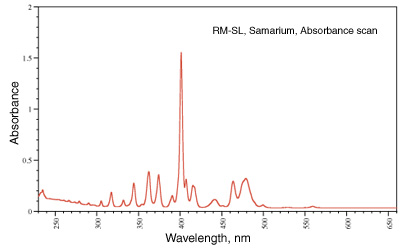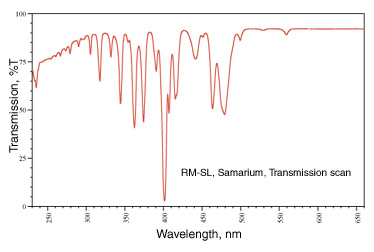
For assessing the wavelength accuracy of your spectrophotometer

| Description | Samarium perchloric sealed in a quartz cell |
|---|---|
| Primary Usage | Verify the wavelength scale of UV/visible spectrophotometers |
| Useable Range | 230nm to 560nm, spectral bandpass of 3nm or less |
| Physical Configuration | Far UV quartz cell that has been permanently sealed by heat fusion |
| NIST Traceability | Each set is supplied with a Certificate of Analysis and NIST Traceability |
| ISO Accredited | Accredited by UKAS ISO 17025, ISO Guide34 and ISO 9001 |
Product Description
View/Download Comprehensive Data Sheet for Samarium Oxide Reference
Samarium perchlorate is a particularly good reference for establishing wavelength calibration because it has useful peaks from 230 to 560nm, many having a spectral bandwidth of less than 5nm. The narrow bandwidth permits the precise locating of peaks. This is a great advantage over glass filters which may have a spectral bandwidth of over 30nm. Samarium is also an excellent material for checking wavelength in the UV as it has many peaks in the UV. In addition to wavelength calibration, the Samarium perchlorate can be used for checking instrument spectral bandwidth. By using peaks in the 230-240 or the 410-420 region, the ability of your instrument to resolve complex peaks can be tested.
| UV Region | Visible Region |
|---|---|
| 235.2 | 401.5 |
| 266.7 | 415.2 |
| 279.1 | 441.2 |
| 280.2 | 463.5 |
| 305.3 | 478.5 |
| 317.6 | |
| 331.7 | |
| 344.6 |
Suggestions for Use
Samarium presents a wide range of structured peaks which
are used to correlate the wavelength indicator on your spectrophotometer
to the known Samarium peaks. The first procedure should be to scan the cell over the useable
range and determine which of the peaks can be resolved. Alter the slit width and scan
rate to produce a useable spectra. Check useable peaks to assure that the reading on
your spectrophotometer is within the manufacturer's tolerances for the
wavelength of your spectrophotometer. Samarium is measured against
an air blank.
Periodically check the spectra, at a minimum in the area where you are
doing your analysis. The periodic use of your Samarium cell will build a log
of your instrument's wavelength accuracy for use with certification and
troubleshooting should the correlation change over time.
Absorbance Scan of Samarium

Transmission Scan of Samarium

Interpertation of Results
Compare the wavelength peaks from your instrument with the expected values on the certificate supplied with the reference set. If the readings are within the expected range for your instrument then your wavelength scale is correct. If not, consult your service techincian and have the instrument evaluated.
Quality program
Each time that the analysis is repeated you can compare the new results with the previous results to check for any variance. If your instrument needs service because of a change in resolution, the historical data will greatly assist the service technician.
How to Order
| Catalog Number | Description |
|---|---|
| RM-SL | Wavelength Reference Cell, Samarium Perchloric, NIST traceable and ISO 17025 |
Download MSDS Sheet for RM-SL Reference